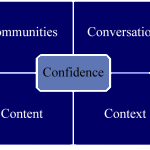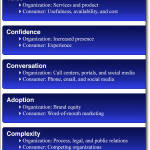The Sentiment Behind the Chatter — IBMdatamag.com

Social media has captured business owners’ attention worldwide, and it continues to be bolstered by massive volumes of big data. While Facebook, Twitter, or any forum or blog offers platforms for communities to gather and share opinions and ideas about products, services, and the like, the content and context are often not clear and completely devoid of emotion. Based on this perspective, what is the business value of social media data?
A significant issue that faces every organization wanting to implement a social media integration strategy is identifying the business value. Understanding one’s customer is extremely critical, and there are several channels to help organizations acquire this understanding. These sources include research firms such as Nielsen and agencies that specialize in aggregating metrics, such as Gnip and Infochimps. Also included are data and metrics providers such as Visible Technologies and expert marketing consultants who can explain a dozen metrics from social media that are necessary.
But where is the business value?
Customer lifetime value (CLV) or wallet share are not metrics that justify such data integration, and neither is the notion of social customer relationship management (CRM) or supplier relationship management (SRM). The real business value from social media is derived when organizations integrate the data and metrics into an analytics engine and can provide insights into the following areas:
Revenue leakage identification and recovery
Cross-sell and up-sell opportunities enhancement
Buyer or prospect risk reduction
Consumer experience improvement
Affinity clusters–to–buying influences identification and classification
Lost opportunities—price elasticity wars
Reputation management
Why do organizations need to justify the business value? The simple reason is businesses do not know where and how to monetize on this data because over the years they have built several processes, workflows, acquisitions, and more. These systems and processes bring about layers of hidden complexities, which can be an entry barrier to integrating any new data.
What sentiment can be determined?
In addition, social media data comes with its own problems such as information quality, timeliness, and effectiveness. Consider the following example scenario. XYZ Corporation is a consumer services company that has a wide variety of services including financial services, insurance, retail stores, grocery chains, and resorts. It has implemented a program called Voice of the Customer that aims at promoting enhanced understanding of its customers and their needs expressed in various channels including call centers, surveys, and emails. This program is a huge step toward connecting to its customers. Here are a couple of engagement situations.
A customer not happy about a situation calls the support hotline and makes the following statement: “I have been very frustrated with the mortgage services and the number of times I have had to follow up with them. I’m not going to engage in this pursuit any further because there is minimal support. I’m very disappointed.”
There is a strong possibility of using some software and ascertaining sentiment, but that is not the insight that is needed. What is needed is to understand the context behind the sentiment and the influence that this type of sentiment can carry to the next set of people that will be influenced. The software can ascertain the sentiment, but relatively leave the context out of the situation. Customers, such as the one in this scenario, may write an email similar to this example in a follow-up to the support call:
This email is a follow-up to my conversation with customer support personnel. I have been a customer and a club member for the last 20 years. While the relationship has had its share of highs and lows, recently your services and products have deteriorated. The store services are poor, and inventory management is bad. The response times have been lagging; there is a lack of commitment to service customer inquiries. In any given situation, the intent appears to be selling more services and not addressing customer needs or issues. I really appreciate self-service channels that you have opened across the organizations, but not all issues are handled in this situation, and we need access to people who have the knowledge and the authority to solve problems. If this trend continues, I regret that I will be forced to look at alternatives.
There are several key issues and associated sentiments in this email that, if not addressed in a timely manner, may result in opportunity costs. Such costs may be an inability to get the wallet share from the customer in a sale that results in word-of-mouth marketing or in a sale that results in a new customer acquisition. Another such cost can be a loss of an opportunity window to cross-sell and up-sell to customers. From these costs, a slow chain of losses can result in further opportunities often going unnoticed in a larger context.
For example, assume the customer posts the same negative consumer-experience sentiments on his or her Facebook page or other social media channel. There is a high probability that other annoyed customers will join this discussion and echo similar experiences. This kind of customer exchange may create a negative community that can definitely cause concern for the organization.
In these two engagements, identifying the customer and having opportunities to address the situation are easy to see. However, if the customer comes through the social media channel, can the organization use its brand reputation as a perspective and justify a business value, but assume the brand was not mentioned then?
How is a connection established?
Consider another situation. XYZ Corporation acquired a business division from another company. The new merger has created a powerful, global team comprising several groups. Though the team will create products and service customers as one group, the geography and cultural diversity demand several adjustments to strategy. The best way to connect to generations of customers is through many channels such as direct sales, email, and social media. In this situation, there are three ways in which the organization can leverage social media:
Connect to customers
Connect internally to create a collaboration and ideation portal
Invite customers to contribute to the collaboration portal
In any of the situations discussed thus far, the core issue is understanding the need of the customer at any given time. To enhance connecting with a customer, organizations should deepen their understanding of the customer, and adopting a five-Cs policy is one way to accomplish this goal (see Figure 1). The five-Cs policy has layers of complexity among the components of the relationship between any organization and its customers (see Figure 2).
Figure 1. A five-Cs policy of social media
Figure 2. Complexities of organization-consumer relationships
These relationship components represent the foundational perspectives that must be weighed to leverage social media and establish a connection to the customer. By peeling the layers, an organization finds several aspects that provide a platform for building the business case for tapping into social media.
Why adopt a social media strategy?
When an organization starts this journey, it realizes that there is more to accomplish from a business and a technology perspective before it can hit a value realization cycle. The key point to remember is the return on investment (ROI) in this exercise is very high and can provide multifold business value returns.
Leveraging social media is a very interesting and complex subject. The technology has matured to address utilizing social media from an enterprise perspective, but there are several hurdles—such as a lack of perceived business value, legal issues, consumer privacy, and other soft problems—that need to be addressed by organizations.
Editor’s note: This article by Krish Krishnan, president and CEO at Sixth Sense Advisors, Inc., is offered for publication in association with the Big Data and Enterprise Architecture Conference, June 11–13, 2014, in New York City. In addition to the author, this conference features Bill Inmon, president and CTO, Inmon Consulting, and James Kobielus, big data evangelist and senior program director for product marketing in big data analytics at IBM and editor in chief, IBM Data magazine. Data Management Forum sponsors the conference.
Please share any thoughts or questions in the comments.
Related articles
Game-Changing Dynamic Insight for Informed Decisions
Sentiment or Sediment?
Social Business: The Power of Big Data in Agile Engagement
How to Get Social Media Analytics Wrong
A Framework that Focuses on the “Data” in Big Data Governance
Source:
The Sentiment Behind the Chatter — IBMdatamag.com


